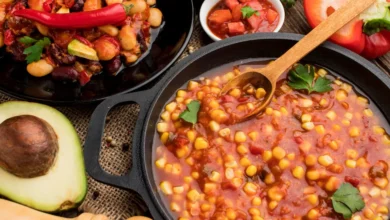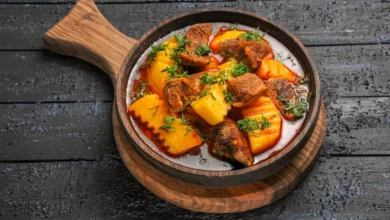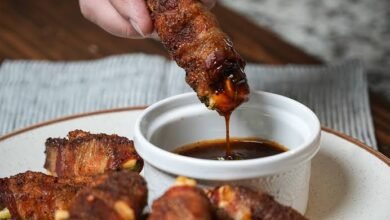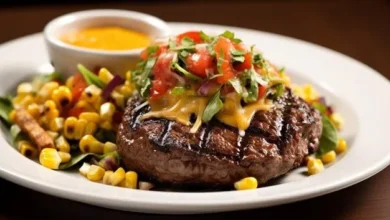Smoked Beef Jerky Recipe: A Step-by-Step Guide
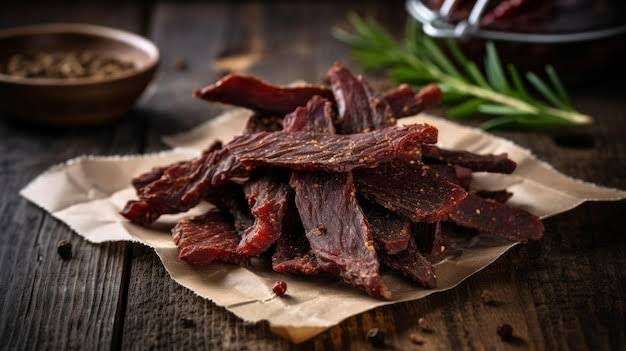
Transform ordinary beef into an extraordinary, smoky, and savory treat with this homemade smoked beef jerky recipe.
Contents
- Smoked Beef Jerky Recipe
- Choose the Right Cuts of Meat
- Slicing Meat for Homemade Jerky
- Preparing Marinade For Beef Jerky
- The Best Temperature to Smoke Beef Jerky At
- Smoking Beef Jerky
- How to Determine When it’s Finished Drying?
- How to Store Smoker Beef Jerky Recipe?
- Pro Tips For Best Smoked Beef Jerky Recipe
- Frequently Asked Questions (FAQs)
- Smoked Beef Jerky Recipe
Smoked Beef Jerky Recipe
Ever heard of jerky? It’s not just a chewy, awesome snack you find at the gas station – it’s got a backstory that dates back to the ancient Inca Empire. The word “jerky” actually derives from “ch’arki,” a term coined by the Quechua, a South American tribe. And get this – ch’arki means “to burn (meat),” which totally makes sense when you think about how we make jerky today.
In those days, the Quechua and other indigenous people needed a way to preserve meat without refrigeration. Their ingenious solution? Drying and burning it, using smoke from wood fires to help the process along. This not only prevented spoilage but also added a unique smoky flavor that we still love today.
Now, thanks to modern technology like the trusty smoker, we can easily recreate this ancient preservation method and create our own delicious beef jerky. Not only is it a great snack for camping trips, road trips, or just a quick bite on the go, but homemade jerky also makes an awesome DIY gift that your friends and family will actually love.
So, there you have it – the fascinating history behind your favorite snack. Ready to learn how to make your own mouthwatering old fashioned smoked beef jerky recipe? Let’s dive in!
Choose the Right Cuts of Meat
When making beef jerky, it’s crucial to start with a lean cut of meat that has minimal fat. The reason behind this is that fat can spoil quickly, leading to a shorter shelf life for your jerky. Some good options to consider are flank steak, round steak, and sirloin. These cuts are not only lean, but also have a fantastic beefy flavor that will shine through in your jerky.
Personally, I’ve found that flank steak is my go-to choice for beef jerky. Its long, flat shape makes it easy to slice into thin, even strips, which is essential for achieving that perfect chewiness we all love in jerky. Plus, the flank steak’s slightly chewy texture holds up beautifully during the drying process, ensuring that your jerky maintains its satisfying bite.
Slicing Meat for Homemade Jerky
The first thing you’ll want to do is slice the meat into thin strips. Aim for ¼ inch slices or even thinner, around ⅛ inch slices. It’s best to slice against the grain, which makes the jerky easier to chew and more tender. If you’re working with round steaks, be sure to slice against the grain once they’re completely thawed – trying to slice partially frozen meat makes it hard to achieve a consistent thickness.
Here’s a tip: Try wrapping the meat in plastic wrap and placing it in the freezer for 1–2 hours to partially freeze it. This step is not mandatory, but it can make slicing meat into consistent widths much easier. Use a very sharp knife and slice the non-frozen beef against the grain into ⅛″-¼″ thick strips. This will ensure they’re easier to chew, whereas slicing with the grain will result in a more chewy texture.
If you want to skip the freezing stage, you can also invest in a jerky slicer like the Weston Jerky Slicer. This nifty tool will slice your meat into perfectly uniform strips of the same width, ensuring they dry evenly. A slicer is especially great if you’re making a lot of jerky.
As you’re slicing, be sure to trim off any silver skin or fat from the meat. Silver skin is not great for smoked jerky, and fat will not cook well and can make the jerky extra hard to chew. Once you’re done slicing, place the slices of meat into a gallon zip lock bag and set aside for the next step.
Preparing Marinade For Beef Jerky
A good marinade is the key to achieving delicious beef jerky. Not only does it add incredible flavor, but it also helps tenderize and preserve the meat. In a medium-sized bowl, combine soy sauce, beer, honey, Worcestershire sauce, garlic salt, onion powder, garlic powder, red pepper flakes, and brown sugar. Give it a good whisk to ensure all the ingredients are well-incorporated.
Next, pour the marinade into the ziplock bag containing your sliced meat. Squeeze out as much air as possible and seal the bag. Place it in the fridge and let the meat marinate for at least 12 hours, but best if you can go the full 24 hours. This extended marinating time allows the flavors to be fully absorbed into the meat, resulting in an incredibly flavorful jerky.
The Best Temperature to Smoke Beef Jerky At
The ideal temperature to smoke beef jerky is between 160-180°F. This temperature range allows the beef to dehydrate slowly without being cooked through. While you can go up to 200°F, anything much hotter runs the risk of drying out the jerky before the inside has properly dehydrated.
Smoking Beef Jerky
Once your meat has marinated for at least 12 hours, remove the bag from the fridge. Lay the slices of meat out on a cookie sheet that’s lined with foil or paper towels. Arrange the meat in one layer, then place a paper towel layer on top, followed by another layer of meat. Continue this pattern until all of the meat is on the tray, mopping up any extra moisture as you go. This step ensures that the jerky will cook and dry out consistently, which is the end goal.
Next, it’s time to fire up your smoker. The key is to keep the temperature low enough to dry out the meat gradually. If you skip this step and cook at too high a heat, you’ll add time to the total cook but risk drying out the outside before the inside is properly dehydrated.
For that authentic smoky flavor, I recommend using apple or cherry wood when making smoked beef jerky. After the first two hours of the meat taking on smoke, check on the meat. If it’s not yet at the desired jerky texture, continue to smoke until it barely bends when you shake it. This usually takes around 2 to 2 and a half hours in the smoker, but times can vary, so keep an eye on it after the two-hour mark. Once it’s reached that perfect jerky consistency, pull off any pieces that look done and let the rest of the batch continue smoking.
How to Determine When it’s Finished Drying?
As you continue to smoke the jerky at around 160°F, you’ll want to periodically check if it’s done. The jerky should bend and crack slightly, but not break completely. To check, pull a piece from the smoker and let it cool for a few minutes. Once it’s cooled down, try bending it. If it cools down and remains pliable after 5–10 minutes, that’s a good sign that it’s done. Letting it cool for 5–10 minutes before checking helps ensure you’re not to over dry the jerky.
Another good indicator is to bend the jerky and see if it cracks, but not break completely in half. If you can see White fibers starting to show, that’s a good indication the jerky has finished drying. In total, it can take anywhere from 5 to 10 hours for the jerky to fully dehydrate, depending on the thickness of the meat and the brand of smoker you’re using.
How to Store Smoker Beef Jerky Recipe?
Once your jerky is done smoking, place it on a rack to cool completely and allow the meat to come down to room temperature. Once cooled, store it in a zip-lock bag or a sealable container in the refrigerator. This will keep it fresh for a few weeks in the fridge, or months in the freezer. Now you’ve got a tasty snack that can be eaten on the go and is packed with flavor and protein!
Pro Tips For Best Smoked Beef Jerky Recipe
- Pellet Smoker Beef Jerky – If you have access to a pellet smoker, it’s one of the easiest options to use for making jerky. The consistent low temperature and controlled smoke make it a fantastic choice.
- Smoked Flavor – For the ultimate smoked flavor, try using Hickory or Apple wood chips. These woods will infuse your jerky with the best flavor profiles.
- Go for Blue, Not White – Avoid thick white smoke as much as possible. If you notice this, increase the temperature slightly to achieve a nice, thin clear/blue smoke. White smoke can impart an unpleasant flavor to your jerky.
RELATED: Smoked Pig Shots With Maple Bourbon Glaze
Final Words From Carmen Foodie
Creating your own smoked beef jerky is a rewarding endeavor that connects you with culinary traditions spanning centuries. The process may take time and patience, but the end result—a flavorful, protein-rich snack that you crafted yourself—is undoubtedly worth the effort. So, fire up your smoker, experiment with different flavors, and enjoy the fruits of your labor.
__________________________________________________________
Frequently Asked Questions (FAQs)
How long does jerky take in a smoker?
The total smoking time can vary depending on several factors, including the thickness of your meat slices, the type of smoker you’re using, and the desired level of dryness. Generally, it takes anywhere from 4 to 10 hours to smoke jerky fully.
Do you flip the jerky while smoking?
No, there’s no need to flip the jerky while it’s smoking. The low temperature and indirect heat will ensure that it dries evenly on both sides.
What is the best temperature to smoke jerky at?
The ideal temperature range for smoking jerky is between 160°F and 180°F. This allows the meat to dehydrate slowly and evenly without cooking.
How long to smoke jerky at 180°F?
At 180°F, it will likely take around 4-6 hours to smoke jerky to the desired dryness. However, always check for doneness by bending and cracking a piece after it cools.
How long to smoke jerky at 200°F?
Smoking jerky at 200°F is not recommended, as it may dry out the meat too quickly and result in a tough, chewy texture.
How long to smoke jerky at 160°F?
At 160°F, it may take 6-8 hours or longer to smoke jerky. This lower temperature will result in a longer drying time but can produce a more tender jerky.
How long to smoke jerky at 225°F?
Smoking jerky at 225°F is not recommended. This temperature is too high and will likely cook the meat instead of dehydrating it, resulting in a less desirable texture and potentially unsafe jerky.
Smoked Beef Jerky Recipe
Course: Smoked CuisineCuisine: American4
servings13
hours20
minutes3
hours228
kcal16
hours20
minutesUncover the age-old secret to preserving meat with a delicious twist – craft your own smoked beef jerky with this accessible recipe that combines history with modern convenience.
Ingredients
3 pounds round steak
¼ cup soy sauce
¾ cup beer
¼ cup honey
¼ cup worcestershire
2 tsp garlic salt
2 tsp onion powder
2 tsp garlic powder
1 tbsp red pepper flakes
¼ cup brown sugar
1 tsp curing salt optional
Directions
- The first thing you’ll want to do is slice the meat into thin strips. Aim for ¼ inch slices or even thinner, around ⅛ inch slices.
- As you’re slicing, be sure to trim off any silver skin or fat from the meat. Silver skin is not great for smoked jerky, and fat will not cook well and can make the jerky extra hard to chew.
- Once you’re done slicing, place the slices of meat into a gallon zip lock bag and set aside for the next step.
- In a medium-sized bowl, combine soy sauce, beer, honey, Worcestershire sauce, garlic salt, onion powder, garlic powder, red pepper flakes, and brown sugar. Give it a good whisk to ensure all the ingredients are well-incorporated.
- Next, pour the marinade into the ziplock bag containing your sliced meat. Squeeze out as much air as possible and seal the bag. Place it in the fridge and let the meat marinate for at least 12 hours, but best if you can go the full 24 hours.
- Once your meat has marinated for at least 12 hours, remove the bag from the fridge. Lay the slices of meat out on a cookie sheet that’s lined with foil or paper towels. Arrange the meat in one layer, then place a paper towel layer on top, followed by another layer of meat.
- Continue this pattern until all of the meat is on the tray, mopping up any extra moisture as you go. This step ensures that the jerky will cook and dry out consistently, which is the end goal.
- For that authentic smoky flavor, I recommend using apple or cherry wood when making smoked beef jerky. After the first two hours of the meat taking on smoke, check on the meat. If it’s not yet at the desired jerky texture, continue to smoke until it barely bends when you shake it. This usually takes around 2 to 2 and a half hours in the smoker, but times can vary, so keep an eye on it after the two-hour mark. Once it’s reached that perfect jerky consistency, pull off any pieces that look done and let the rest of the batch continue smoking.
Notes
- Try wrapping the meat in plastic wrap and placing it in the freezer for 1–2 hours to partially freeze it. This step is not mandatory, but it can make slicing meat into consistent widths much easier. Use a very sharp knife and slice the non-frozen beef against the grain into ⅛″-¼″ thick strips. This will ensure they’re easier to chew, whereas slicing with the grain will result in a more chewy texture.
- If you want to skip the freezing stage, you can also invest in a jerky slicer like the Weston Jerky Slicer. This nifty tool will slice your meat into perfectly uniform strips of the same width, ensuring they dry evenly. A slicer is especially great if you’re making a lot of jerky.
- The ideal temperature to smoke beef jerky is between 160-180°F. This temperature range allows the beef to dehydrate slowly without being cooked through. While you can go up to 200°F, anything much hotter runs the risk of drying out the jerky before the inside has properly dehydrated.
- Once your jerky is done smoking, place it on a rack to cool completely and allow the meat to come down to room temperature. Once cooled, store it in a zip-lock bag or a sealable container in the refrigerator. This will keep it fresh for a few weeks in the fridge, or months in the freezer. Now you’ve got a tasty snack that can be eaten on the go and is packed with flavor and protein!

